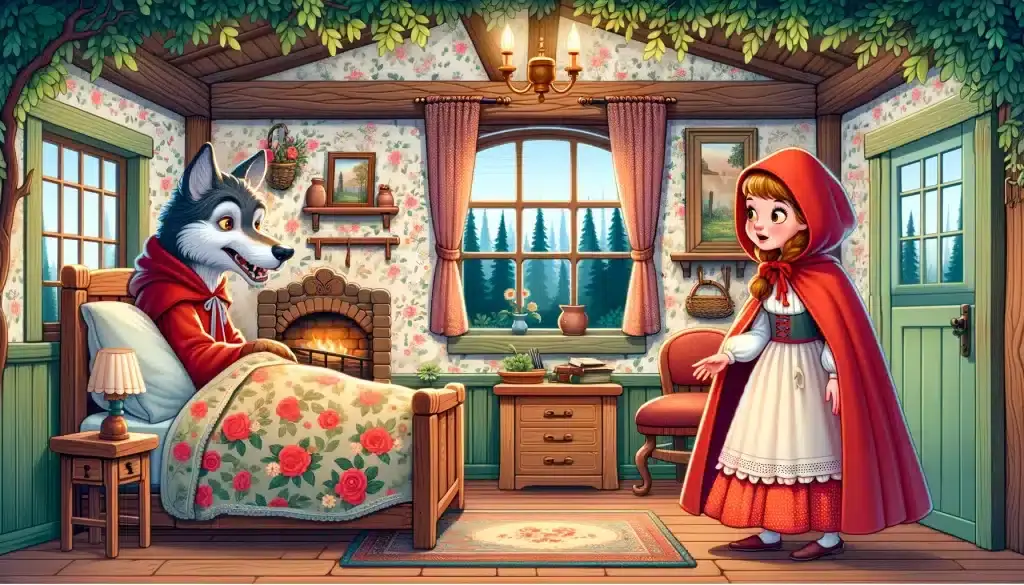Little Red Riding Hood, a timeless tale woven into the fabric of fairy tale history, resonates as a powerful cautionary story. Stemming from a long tradition of oral storytelling, this narrative has been passed down through generations, finding its way into the hearts and minds of children and adults alike. It offers valuable lessons about the potential perils of ignoring warnings and the risks of interacting with strangers.

With roots tracing back to European folklore, variations of ‘Little Red Riding Hood’ have been recounted in many cultures, each with its own unique spin on the central message. The versions popularized by Charles Perrault and the Brothers Grimm have cemented the story’s status in literary canon. They’ve sharpened its moral lessons, emphasizing the importance of vigilance and obedience.
The tale, although simple in its structure, opens a window to discuss complex themes such as trust, innocence, and the duality of human nature. As Little Red Riding Hood encounters the cunning wolf, readers are taught to be cautious on their paths through life and reminded of the importance of being mindful of those they encounter.
Origins and Evolution of the Tale
The tale of Little Red Riding Hood has a rich history, originating from ancient oral traditions and evolving through literary adaptations. It showcases the adaptation of folklore through generations.
Historical Context
Little Red Riding Hood, known in French as Le Petit Chaperon Rouge, has origins that some experts trace back to the Middle East nearly 2,000 years ago, later spreading through Europe. Anthropological studies suggest that the fable might have been used to impart lessons about the perils that lurk beyond familiar territory.
Oral Storytelling and Literary Adaptations
Before becoming the written stories known today, tales like Little Red Riding Hood thrived as part of the oral storytelling tradition. These stories were often modified to suit the audiences and cultural contexts of the time. Transitioning from oral narratives, these tales were recorded in literature, with variations becoming evident across different regions.
Influential Authors
Two of the most notable literary versions of Little Red Riding Hood were penned by Charles Perrault and the Brothers Grimm. Perrault’s rendition, Le Petit Chaperon Rouge, introduced a red-cloaked girl and a moral for children about the danger of talking to strangers. Meanwhile, the Brothers Grimm’s version, Rotkäppchen, is known for its darker tone and inclusion of a rescue scene. Other influential works include Puss in Boots, which, like Little Red Riding Hood, underscores the theme of cunning overcoming brute force.
Synopsis of Little Red Riding Hood

This synopsis uncovers key events in the cautionary tale where Little Red Riding Hood faces peril upon straying from her path and encountering a wolf.
Setting the Scene
In a quaint village, Little Red Riding Hood, known for her distinctive red cloak, receives an important task. Her mother asks her to deliver food to her grandmother who lives in another village, separated by the woods.
Red Riding Hood’s Journey
As she journeys through the woods, Red Riding Hood is oblivious to the dangers hidden within. She carries a basket of nourishing food, intending to help her ailing grandmother regain strength.
The Encounter with the Wolf
A cunning wolf encounters Red Riding Hood and engages in a sly conversation. The wolf’s hidden agenda is to trick her, luring her away from safety with charming words.
Grandmother’s House: The Climax
Upon arriving at her grandmother’s house, Red Riding Hood finds the wolf dressed in her grandmother’s clothes, lying in the bed. A moment of confusion leads to the reveal of the wolf’s devious trick.
The Resolution
The tale concludes with a woodsman coming to the rescue. He saves both Red Riding Hood and her grandmother, illustrating the importance of being cautious and wary of strangers.
Themes and Morals

The tale of Little Red Riding Hood is rich with lessons about the wisdom of obeying rules and the risk of trust misplaced. As a continually told and retold story, it conveys timeless lessons about human nature and societal expectations.
The Perils of Disobedience
Little Red Riding Hood was explicitly instructed by her mother not to stray from the path to her grandmother’s house, yet she was tempted and ultimately gave in to distraction, which sets the stage for her encounter with the wolf. This act of disobedience tragically illustrates the potential dangers that come from ignoring guidance, underscoring a moral that adherence to rules can serve as protection against unforeseen threats.
The Importance of Trust and Caution
This narrative stresses that not everyone who is friendly should be trusted, warning of the hazards of talking to strangers. Little Red Riding Hood’s naive trust in the wolf—a stranger—leads her into danger, highlighting the importance of being cautious about whom to trust. This serves as a powerful lesson on the exercise of discernment and caution in social interactions.
Innocence versus Cunning
Innocence in the story is portrayed by Little Red Riding Hood, while the wolf embodies cunning. Through deception, the wolf manipulates the truth to serve his own desires, pitting guile against the girl’s purity. This contrast between innocence and cunning provides insight into the complex ways deception can operate in the world.
Gender Roles and Power Dynamics
Gender roles and power dynamics play a prominent role, often showcasing the vulnerability of the female character contrasted with the dominance of the male wolf. This dynamic explores patriarchal concepts of female promiscuity and strength, emphasizing how gender can shape interactions and perceptions of power.
Character Analysis

In exploring the characters of “Little Red Riding Hood,” it becomes evident how each one contributes to the tale’s cautionary nature. Let’s examine their unique roles and transformations throughout the story.
Protagonist: Little Red Riding Hood
Little Red Riding Hood, nicknamed for her distinctive garment, represents innocence and naivety. Her trust in the wolf sets the stage for the ensuing drama. Known for her red cloak, she is a symbol of childhood and vulnerability.
Antagonist: The Wolf
The wolf emerges as the cunning wolf, embodying deception and danger. He exploits Red Riding Hood’s innocence, illustrating the risk of talking to strangers. His actions drive the story’s warning about the perils outside the safety of the beaten path.
The Supportive Cast
Supporting characters include the grandmother, an embodiment of wisdom and kindness, and the woodsman, representing protection and vigilance. The grandmother is an old lady who becomes a victim of the wolf’s deceit, while the woodsman intervenes, highlighting the importance of guardianship and the potential consequences of straying from the path.
Character Transformations
As the tale unfolds, each character undergoes a transformation. Red Riding Hood learns the harsh lesson of caution, moving from innocence to a more wary understanding of the world. The wolf, in contrast, goes from a menacing figure to a defeated antagonist, underscoring the triumph of vigilance over cunning.
Cultural Impact and Adaptations

The story of “Little Red Riding Hood” has traversed centuries, evolving with every retelling, influencing literature, media, and societal norms.
Literature and Education
In the realm of literature and education, “Little Red Riding Hood” serves as a staple in children’s reading curriculums. Teachers utilize this fairy tale to impart lessons on the risks associated with naivety and the virtues of caution. The narrative’s European origins and transmission through oral storytelling have allowed it to become a classic in folktale studies. This story’s adaptations are numerous, such as the reversal of roles in “Little Red Riding Wolf,” offering a fresh perspective on the tale.
Media and Entertainment
“Little Red Riding Hood” has left an indelible mark on media and entertainment. Its themes spawn countess film adaptations, theatrical performances, and television episodes. The story’s chilling premise captures audiences’ imaginations, reminding them of the dangers lying beyond the beaten path. It even makes its way into animation, with modern retellings softened for younger audiences to enjoy without fear.
Sociocultural Interpretations
The sociocultural interpretations of “Little Red Riding Hood” reflect society’s evolving views on childhood and morality. The tale acts as a mirror, revealing changing attitudes towards nurturing and protecting the young. It also plays a role in discussions about the portrayal of women and the dynamics of power and vulnerability, as depicted in the interactions between Red Riding Hood and the wolf. Whether exploring its complex roots or its transformation into a symbol of our cultural psyche, the narrative endures, as highlighted by Book Riot.
Practical Lessons and Applications

Little Red Riding Hood’s narrative offers valuable lessons on safety and distrust of strangers, emphasizing the need for vigilance.
Advising the Young: Teaching Caution
When educating children, the story urges the importance of adherence to instruction. Young ones are often taught that deviating from a safe path can lead to unforeseen dangers. The tale serves as an age-old metaphor, illustrating the outcome of ignoring warnings and the significance of being cautious.
Beyond the Tale: In Real-Life Contexts
In everyday life, the principle of not talking to strangers translates into teaching individuals to protect their personal safety. It reinforces the importance of assessing the intentions of those we meet and to remain alert in unfamiliar situations. This fable’s advice is reflective of the wisdom found in the ancestral teachings passed down through generations.
Relevance in Modern Society
Modern society still sees relevance in Little Red Riding Hood’s cautions. The narrative’s core message—not to trust strangers blindly—is as pertinent as ever, reminding both young and grown-ups that not everyone may have good intentions, similar to Little Red Riding Hood’s sick grandmother being deceived by the wolf. The story is a reminder that while the world can be full of sweet intentions, it also harbors potential threats, necessitating a careful balance between trust and caution.
Steve is the creative force behind My Unique Tales, a blog dedicated to sharing captivating stories that explore the human experience in all its complexity. With a passion for writing and a talent for crafting engaging narratives, Steve's blog is a treasure trove of imaginative tales that transport readers to other worlds and challenge them to see things from new perspectives. From epic adventures to intimate character studies, Steve's stories are always thought-provoking and emotionally resonant. With a growing following of readers who appreciate his unique voice and creative vision, Steve is quickly becoming a rising star in the world of online storytelling.






